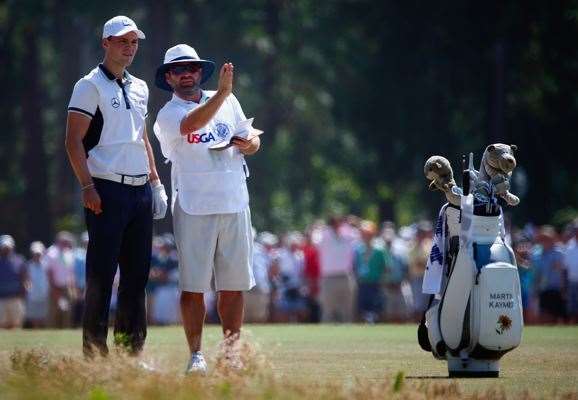A re-tooled game and steely resolve combined to give Germany’s Martin Kaymer an emphatic victory at Pinehurst for his second major title, writes Steve Keipert.
By Steve Keipert
The old adage tells us you can’t win a tournament on Thursdays, they can only be lost in the opening round. However, just occasionally those adages are proven wrong. Tiger Woods had the 2000 US Open won before the first-round TV broadcast began; Rory McIlroy did similarly 11 years later. And the new champion Martin Kaymer effectively sewed up his second career major while most Australians were eating a Friday breakfast.
In truth, Kaymer sealed the 114th US Open with a scintillating first two rounds, yet the signs were ominous from the outset that the real race at Pinehurst No.2 was for second place. An opening 65 sent the 29-year-old from Dusseldorf to five-under the card, a depth below par no one else reached at any moment all week. The next morning he did it again, carding a second 65 to take the championship out of the other 155 players’ grasp. No one had ever shot better than 66 at a Pinehurst US Open and Kaymer managed it twice in 24 hours.
It was a barrage similar to the German’s blistering performance at the Players Championship a month earlier, when he began 63, 69 but hung on to win by just a shot. This time he was part golfer, part cyborg as no one else in the field threatened. Kaymer’s lead never dipped below four strokes during the weekend rounds and the closing nine holes became a procession culminating in an eight-stroke romp.
As far as precision goes, Kaymer’s play was in the same class as his country’s finest automotive engineers. He was ruthlessly efficient, minimising mistakes and rolling in long birdie putts at regular intervals. For 36 holes he played like he was touring another of Pinehurst’s eight fabled layouts.
He broke the 36-hole US Open scoring record with his twin 65s to reach ten-under-par. He carded 11 birdies against just one bogey, requiring only 32 holes to reach double-digits in the red. Kaymer became the sixth man in US Open history to reach ten-under and only McIlroy’s 26-hole opening blast in 2011 saw the mark attained faster.
The putter was Kaymer’s friend as he frequently holed key putts but also used the flatstick to great effect when he did miss greens. Some players chipped, others pitched or bunted hybrids and fairway woods from off the edges of Donald Ross’ sinister domed greens. Kaymer, though, kept it simple by leaning on his putter wherever possible – and time after time rolled the ball close enough to convert the save.
His swing is so powerfully simple, his putting so pure and his temperament so perfect that it’s difficult to see how or why Kaymer slid down the world ranking and went missing from leaderboards after reaching world No.1 shortly after winning the US PGA in 2010. An inveterate fader of the ball, his fall then rise is partially explained by a bid to chase a reliable right-to-left ball flight, a project at least partly motivated by his repeated inability to conquer Augusta National.
But when you’re on a good thing you stick to it. The only six-time Masters champion also favoured a fade and yet found a way to tame Augusta. And Kaymer’s US Open gameplan was distinctly Nicklausian, dismantling the revered No.2 layout at Pinehurst in clinical fashion with few errors.
“I didn’t make many mistakes in the last two wins I’ve had in America – especially this week,” said Kaymer, who joins a band of players including Tom Watson, Seve Ballesteros, John Daly, Ernie Els, Woods and McIlroy to win two majors before their 30th birthday. “I played very solid the first two days and that gave me a nice cushion for the weekend. But to shoot only one-over-par at Pinehurst on Saturday and Sunday is good. The way I played, I was happy. The way I kept it together yesterday gave me a good cushion for today.”
Kaymer held a six-stroke lead at the midpoint, equalling the records of Woods in his destructive 2000 season and McIlroy three years ago. No US Open 36-hole leader has blown a halfway lead greater than four strokes. In fact, since World War II only once has a player squandered a 36-hole lead greater than four shots at any major: Bobby Clampett failing from five strokes clear at the 1982 Open Championship.
The turning point in Kaymer’s third round came on the 4th and 5th holes, two holes where the pars were switched in Bill Coore and Ben Crenshaw’s restoration three years ago. Kaymer drove the ball left both times, requiring a penalty drop from an unplayable lie in the pine straw on the par-4 4th before sinking a 20-foot putt to save bogey. At the par-5 5th he executed a perfect mid-iron from the sandy waste left of the fairway to set up a short eagle putt that he holed. Two missed fairways still resulted in a one-under stretch and Kaymer’s lead swelled to seven strokes.
One hole later Kaymer made a bogey despite hitting the green in regulation and taking two putts. How does that work? Not the only player to do so, Kaymer barrelled his first putt well past the hole to the crest of one of Pinehurst’s famous crowned greens. The ball gathered pace and trickled well off the green and no closer to the cup than where he’d started. Such is Pinehurst No.2, where even finding the greens is no guarantee the job is finished trying to board these maniacal surfaces.
Every time Kaymer seemed to be in trouble on Saturday he’d conjure a recovery shot in the manner Coore and Crenshaw envisioned. Frequently it was an iron shot from the waste area that found the green but around and on the putting surfaces Kaymer was noticeably superior. In the cauldron of the US Open, he was rarely found to be wanting. A pinpoint approach at the 18th kept his lead at five strokes at eight-under, a commendable result on a challenging day.
To see the equipment Martin Kaymer used to win at Pinehurst, click here
Queueing behind the German was a colourful, eclectic cast, led by the unlikely Erik Compton, a two-time heart transplant recipient seeing weekend play for the first time in just his second major. Also at three-under sat Rickie Fowler, who like Compton carded a best-of-the-day 67 in round three. World No.2 Henrik Stenson lurked among the contenders throughout and was two-under alongside Dustin Johnson, with Brandt Snedeker at one-under the only other player in red figures after 54 holes. With Kaymer looking so unflappable, these men stood as the only combatants with any faint hope.
The week’s other winner was the revamped Pinehurst No.2 course. In an age when water conservation is paramount, the firm, dry playing surfaces served as a timely reminder of how fun and compelling bouncy turf makes the game. This is especially so for golfers seduced each April by the endless green swathes of Augusta National, which sits on a pedestal on its lonesome when it comes to any discussion about conditioning and course set-up. The wide fairways and crowned greens of Pinehurst No.2 pair beautifully with the region’s natural sandy wasteland that blurs the lines between success and failure while offering a lucky-dip when it comes to viable escapes. Only the player can truly decide what they can and can’t get away with on the next shot. It’s a look and approach we should see more often, saving water and making golfers exercise the most dangerous six inches in the sport: that space between their ears. Chances are the championship recipe is right when the field is frustrated but also fulsome in their praise.
* To read the full story behind Martin Kaymer’s US Open victory, get the July issue of Golf Australia magazine
HOW THE AUSSIES FARED
Of the 11-strong Australian contingent, only Jason Day, Adam Scott and Aaron Baddeley made the cut. All three loitered mid-pack over the weekend before a Sunday flurry from Day pushed him back to even-par late in the round, his good work undone slightly by a final-hole bogey. His 281 total is a score that wins many US Opens, but not this one. Day’s hot finish gave the 26-year-old his third top-four finish in the past four US Opens, adding to his credentials as a tough-course specialist.
Scott also broke 70 twice to finish a stroke behind Day, sealing his first career top-ten at the season’s second major. His putter was ice cold in the first round but he rebounded with a 67 on Friday that was bettered only by Kaymer’s 65. While never in contention, Scott finished a mere three strokes out of second place.
Baddeley showed typical flashes of brilliance mixed with stretches of wayward golf and dropped shots, yet his tie for 23rd represents his best major result since the Masters five years ago.
U.S OPEN LEADERBOARD
Pinehurst No.2, Pinehurst, North Carolina
6,915 metres, Par-70
US$8,000,000, June 12-15
1. Martin Kaymer (Ger) 65-65-72-69—271 US$1,620,000
T2. Erik Compton (US) 72-68-67-72—279 789,330
T2. Rickie Fowler (US) 70-70-67-72—279 789,330
T4. Keegan Bradley (US) 69-69-76-67—281 326,310
T4. Jason Day (Qld) 73-68-72-68—281 326,310
T4. Brooks Koepka (US) 70-68-72-71—281 326,310
T4. Dustin Johnson (US) 69-69-70-73—281 326,310
T4. Henrik Stenson (Swe) 69-69-70-73—281 326,310
ALSO:
T9. Adam Scott (Qld) 73-67-73-69—282 US$230,900
T23. Aaron Baddeley (Vic) 70-71-73-72—286 79,968
MISSED CUT (145):
Rod Pampling (Qld) 73-73–146
Matt Jones (NSW) 74-72–146
John Senden (Qld) 71-76–147
Geoff Ogilvy (Vic) 73-74—147
Brady Watt (WA) 77-74—151
Steven Alker (NZ) 76-76—152
Robert Allenby (Vic) 79-73—152
Aron Price (NSW) 78-74—152
Oliver Goss (WA, a) 71-83—154
Related Articles

Review: Clearwater Golf Club

Review: Omaha Beach Golf Club
















